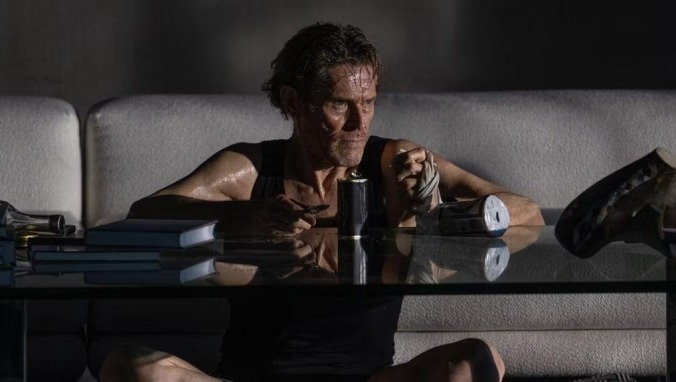Inside review: Being stuck in a room with Willem Dafoe is pretty thrilling
Dafoe plays an art thief trapped in a high-tech Manhattan apartment in this cunning, immersive art world critique

With his acerbic eyes on the brink of mischief, and a knowing smile that often suggests something a little darker than meets the eye, Willem Dafoe, the star of The Last Temptation Of The Christ and At Eternity’s Gate, is among cinema’s great burdened souls. For Inside, Dafoe puts to work every angular muscle and wrinkle of his visage to unnerving effect. He’s the perfect lead for writer-director Vasilis Katsoupis’ resourceful and immersive survival tale, one that puts a gradually tortured protagonist through the wringer in unimaginable ways.
In fact, Dafoe is pretty much the only character in this unexpectedly thrilling psychodrama, save for a maid that his character sees through the intercom of the luxury high-rise apartment he’s stuck in, and a poor pigeon with a grim fate as wretched as his. It all starts when Nemo (Dafoe), an agile and crafty art thief, swiftly enters the coldly chic and high-tech midtown Manhattan penthouse in question, home to a well-heeled artist with an impressive collection of artwork, from Egon Schiele to Francesco Clemente.
The drill is simple enough: Nemo needs to move quickly through the sparsely decorated, ultra-sophisticated space and collect the priceless works of art (authentic works gathered for the film by curator Leonardo Bigazzi) with the help of a voice on the other end of his walkie-talkie he calls Number 3. But when the apartment’s seemingly unbreakable security system malfunctions on Nemo’s way out, all possible avenues of exit are shut down and Number 3 vanishes, leaving Nemo abandoned inside an unfriendly space that’s unwilling to provide for his basic needs like food, water, and livable temperature levels.
While it’s a bit of a cliché to refer to a film location as a character in its own right, doing so for Inside is perhaps the only way to do justice to the level of heavy-lifting done by Thorsten Sabel’s ingenious production design in telling this story. Indeed, every part of the penthouse where the entirety of Inside unfolds is a tool in Ben Hopkins’ script (which was developed from an idea by Katsoupis). Broadly speaking, their joint effort resembles an escape room challenge or, more accurately, a quiet (and sometimes humorous) survival saga like All Is Lost where wealth and luxury (instead of mother nature) are the perilous sources of a hostile environment containing scores of priceless art that are as useful to Nemo as wads of cash would be to Robinson Crusoe on a desert island.
Still, that Nemo is an artist—at least twice, his voiceover tells us that his sketchbook is among his most-prized possessions—comes in handy to the lonesome fighter. Throughout Inside, he operates like an engineer-cum-installation artist, capable of building a makeshift escape ladder to the skylight of the apartment’s impossibly high ceilings. Before that, he carves a hole in a handsomely ornate wood door frame only to (expectedly) hit its steely foundation. Then he eliminates other escape options like trying to be heard or seen as he comes to realize that the wealth he’s encased in has made him inaccessible—as the owner of the space intended. So he breaks, destroys, unscrews, and mounts the furniture available to him, hoping to climb out of his spacious prison that gradually malfunctions with extreme hot and cold temperatures. To make matters worse, he has no water except for a timed indoor sprinkler and no food to speak of other than a few cans of innutritious food and some crackers.
Throughout this one-location nail-biter, you can unambiguously see the collaboration between Katsoupis, Hopkins and Sabel expanding the story’s scope in ways both economical and smart and with the backdrop of a distancing and icy Brutalist aesthetic. Also noteworthy is Bigazzi’s cohesiveness—the artworks he’s selected (especially a family photograph) focus on the eyes, creating a collectively spine-tingling sense that Nemo is constantly being watched from within.
As with most works of art, the message of Inside is in the eye of the beholder. It’s possible to read this original exercise as a critique of extreme wealth and pretentiousness in the art world, neither of which can nourish one’s body or save a human from their eventual demise. It’s also possible to get overwhelmed, bored or feel unmoved by the repetitiveness of it all as time and seasons pass, Nemo’s feces accumulates and the once stonily elegant flat becomes uninhabitable. This critic firmly leans towards the former reading—it is in fact admirable that Katsoupis leaves Inside open-ended without getting heavy-handed or preachy. Still, the greatest asset of the picture is Dafoe’s finesse in a part that’s both physically demanding and fiendishly fun to witness. It’s like someone dropped him in the middle of an antique shop with a baseball bat and said, “Go to town!” And that he does.
(Inside opens in theaters March 17)